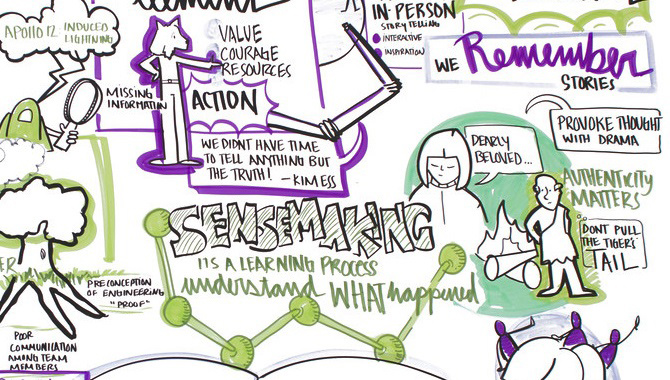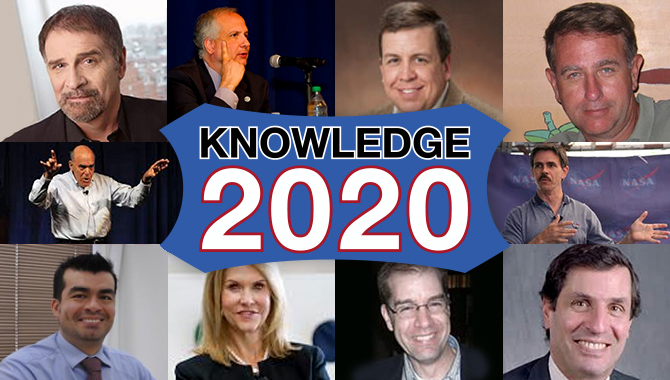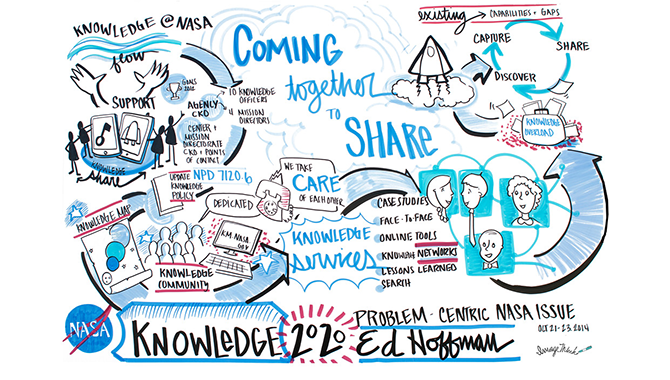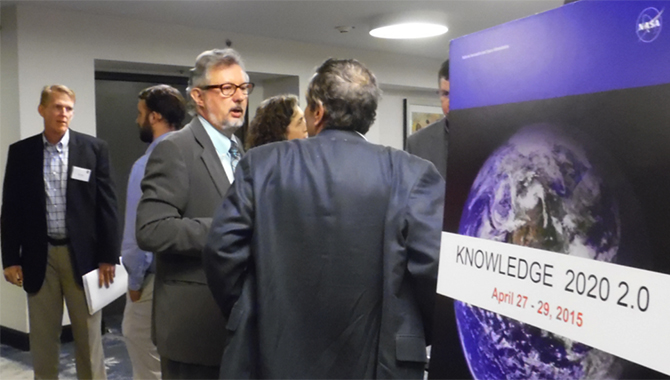
ImageThink created posters to capture presentations and discussions as they occurred live at October’s Knowledge 2020 Conference. This poster captured the “one-armed caveman” who told—with authority--why you should not pull a saber-toothed tiger’s tail.
Image Credit: ImageThink
Tom Magliozzi, the elder of “Click and Clack: The Tappet Brothers” of NPR’s Car Talk, recently died, and the Internet has not been consistent with one of his most famous quotes. Did Tom say, “Never let the facts get in the way of a good answer” or did he say, “Never let the facts get in the way of a good story”?
If “stories” are “answers” and “answers” are “stories” all of the time, then no one should lose sleep over this discrepancy. Sometimes, the two being equal is supported by the facts.
A caveman–missing an arm–walks into a bar. The bartender asks him, “Hey, is it a good idea to pull a saber-toothed tiger’s tail?”
Last month at Knowledge 2020 (K2020) on the “Space Coast” of Florida, Larry Prusak—author, consultant, researcher, founder and director of The Institute for Knowledge Management—stood in front of a roomful of knowledge service practitioners from NASA and other highly technical organizations. With arms outstretched, Prusak stated without wavering: “For any idea to have any impact, you have to have some cognitive authority… there have to be case studies… it has to be taught… there has to be structures to it… have some very serious books tie it to the economics of an organizations, to global economics, to how the world works.”
The caveman, with the hand on the arm he still has, points to where his other arm used to be.
The linchpin to Prusak’s declaration is “cognitive authority,” that people capture knowledge first-hand from their own experiences or second-hand from someone else’s experience. When people mostly depend on others for knowledge outside of direct experience, much of what they think they know has been gained second-hand. The transfer of experience best happens at that “teachable moment,” which Carla O’Dell, President of American Productivity & Quality Center, mentioned when she presented at K2020 after Prusak.
Now imagine our one-armed caveman by a campfire, surrounded by Paleolithic youths, relating a story about a saber-toothed tiger…
After a session on “Knowledge and Narrative” at K2020, the presenter Don Cohen—author, consultant, and former editor of NASA’s ASK Magazine—captivated the attendees by describing how stories create context for content, followed by attendees asking questions and spinning a bit of their own yarn. David Oberhettinger, Chief Knowledge Office at NASA’s Jet Propulsion Laboratory, told a story about a one-armed cave man telling a story about why not to pull a saber-toothed tiger’s tail. His tale–a tale within a tale about a tail–engaged the conference so much, that the one-armed caveman was sketched by ImageThink graphics illustrators like a painting on a cave wall.
Throughout K2020, knowledge practitioners–from highly technical organizations like Merck Manufacturing and Ecopetrol–shared their leading practices and lessons learned in their own knowledge management and services endeavors. And speakers listened when the audience shared. Stories provided answers, and answers were told as stories. Stories were shared at K2020, and now stories are shared about K2020, building on each other.
Tom Magliozzi and his brother Ray were both graduates of MIT, and in 1999, they both spoke at their Alma Mater’s commencement. Clearly, Tom was the more provocative speaker. He dismissed Newton’s famous quote about scientific progress, that is achieved as we stand “on the shoulders of giants” to see further. “In some areas, yes, we do in fact benefit from what our predecessors have done,” declared Tom, “but in other areas, mostly like the human involvement kinds of areas, we may in fact all be destined to make the same mistakes over and over and over again…”
In NASA at 50: Interviews with NASA Senior Leadership, Bryan D. O’Connor, former NASA Chief Safety and Mission Assurance Officer, shared: “(w)e tend to beat ourselves up and get advice from our own mishap investigations on where our failings are, but we also have people calling all the time asking us how we do this and the other, looking to benchmark NASA on how it does safety practices.”
The one-armed caveman has authority when he tells a tale.
It is only through the repetition of these stories, by keeping them in the forefront of our minds, that we will mitigate or even cease making the same mistakes. That’s why history and stories are important. That is why knowledge management and services, which creates a community of experts and expert listeners, are important. And that is why millions of thankful people tuned into two brothers giving advice on cars (and everything else) for nearly four decades.








